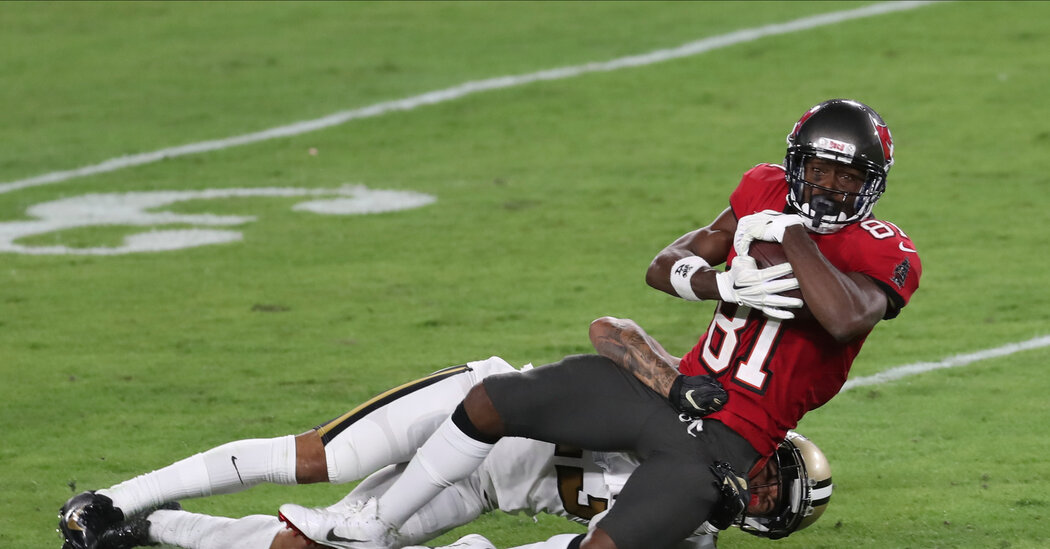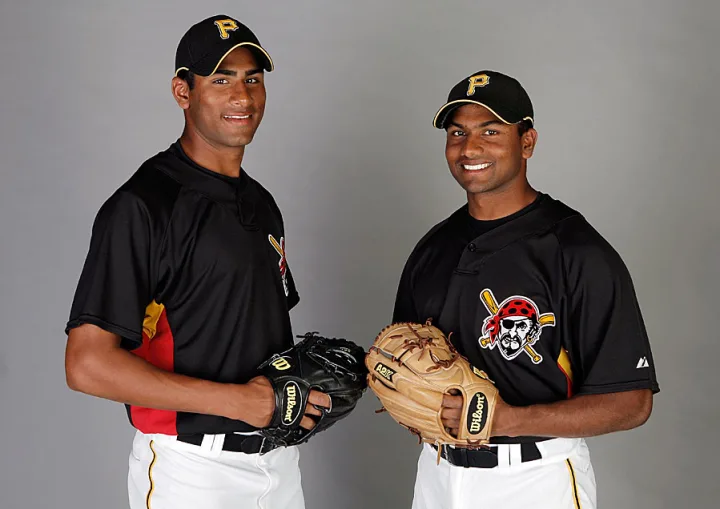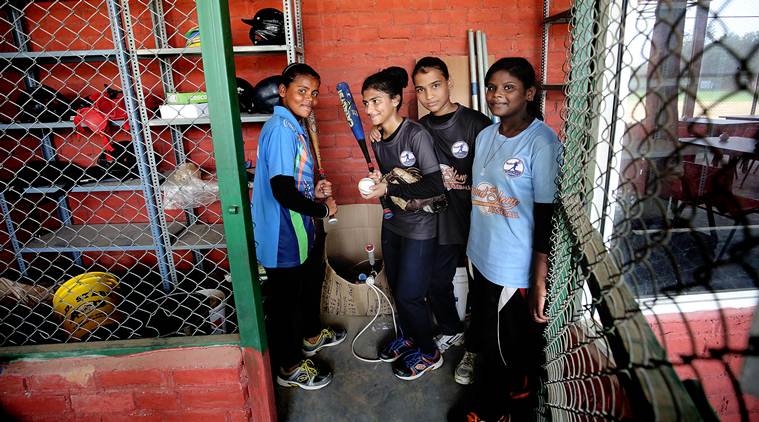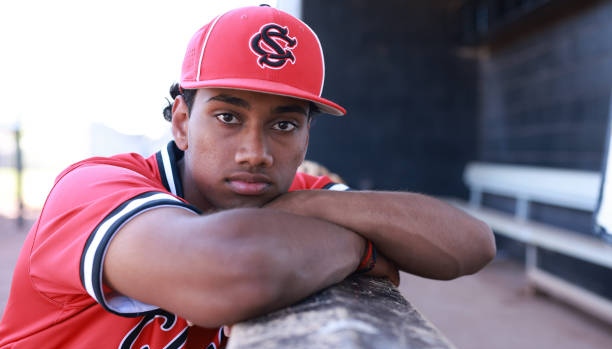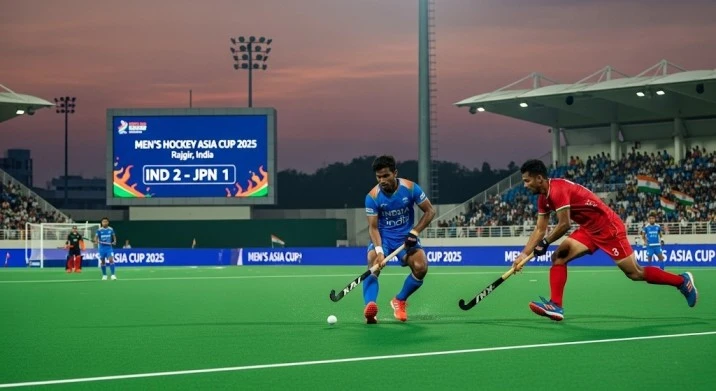The matchup had been anticipated all season: Tom Brady and Drew Brees, two sure-shot Hall of Fame quarterbacks nearing the ends of their careers, facing off in prime time on Sunday. The fact that their teams, the Tampa Bay Buccaneers and the New Orleans Saints, are battling for control of the N.F.C. South only raised the stakes.
This is the N.F.L., though, where troublesome personalities on the field sometimes steal the show, or at least a lot of the attention. In this case, it was the debut of Antonio Brown with the Buccaneers.
Brown, an All-Pro wide receiver returned to the field for the first time in 16 months after tumultuous breakups with three teams, self-destructive explosions on social media and several lawsuits, one of which led to an eight-game suspension. Another one — a civil suit accusing him of sexual assault and rape — may go to trial as soon as next month.
If that were not problematic enough, his return to the field came with the full-throated endorsement, if not machinations, by Brady, who had bonded with Brown during a brief stint with the Patriots and is even lending him a room in his Tampa-area mansion.
In the end, Tampa needed a receiver and was willing to look past any off-field transgressions, though on Sunday they appeared to need a lot more as the Saints blew them out, 38-3, and Brown caught only three passes.
Yet Brown’s return to the N.F.L. — after all his legal troubles, his threats to retire and his bad-mouthing of former employers — raised fresh questions about the league’s tolerance for players who act poorly off the field, particularly when it includes accusations of violence against women, an issue that has dogged the league for years.
The N.F.L. professes to hold players accountable when they damage the league’s brand. And, indeed, the league suspended Brown for eight games this season — a hefty penalty by its standards — and Brown could be suspended again depending on what is disclosed during his civil suit.
But in allowing Brown to suit up yet again, the league risks tacitly normalizing his behavior, which has included fights with a general manager, livestreaming embarrassing video in his team’s locker room and a grievance over which helmet he could wear.
Under the cloak of offering second chances, teams often look past a player’s behavior if he has something to offer on the field. Undeniably, Brown, 32, has been immensely talented. His 68 touchdown receptions since 2013, even after sitting out a season and a half, are still the most among active receivers.
Teams want to win championships and bet that fans and sponsors will also look past players with checkered lives. In that light, Brown is simply another hired gun, albeit one with a trail of burned bridges, hired to get the Buccaneers to the promised land. He joins other mercenaries like Brady, who signed a $60 million, two-year contract in March; Brady’s favorite tight end, Rob Gronkowski, who came out of retirement; and running back Leonard Fournette, who spent three rocky years with the Jacksonville Jaguars.
“Discipline in the N.F.L. has an inverse relationship to a player’s talent on the field,” said Nellie Drew, the director of the Center for the Advancement of Sport at the University at Buffalo School of Law.
In other words, the more talent, the more likely a team looks the other way.
The Buccaneers provided all the usual caveats, some of which required back flips and contortions. Coach Bruce Arians said in March he had no interest in Brown. Now that the team has several injured receivers — and a star quarterback who wanted him — Brown seemed like a better fit. Arians added that there was no inconsistency between his well-deserved record of hiring women and signing a player accused of sexual assault.
Arians noted that Brown had not been convicted of any crimes. (Brown pleaded no contest to felony burglary and battery charges after an altercation with a truck driver, an episode that led to his eight-game suspension.) Arians said that Brown was in “great shape,” had been “positive” and was “moving forward.” Arians and other coaches on the Buccaneers know Brown from their days together with the Pittsburgh Steelers and would provide support.
Even so, Arians suggested Brown would be on a short leash.
“I think let the court system do its job,” Arians said. “I mean allegations, I’ve been around a lot of players facing allegations that weren’t true. Some were. So let the court system handle it, and if it’s found out to be true, he won’t be with us.”
In some ways, Brown is getting less scrutiny than he would in a normal season. Because of the pandemic, fewer fans are in stadiums, so there is less chance of Brown being booed.
Reporters are not allowed in clubhouses this year, so there are no television cameras camped out at his locker. All interviews are done by video conferencing, and team personnel control who asks questions and how long interviews last.
Last week, Brown, who wore a “TB12” cap denoting Brady’s health and wellness company, told reporters that Brady was instrumental in his return and had introduced him to the motivational speaker Tony Robbins. Brown said he has been “working on myself within and without” and “not listening to the naysayers.”
Still, he hoped to “win them over in my actions, how I move forward and how I handle my business.”
Television broadcasters have a different task when discussing Brown because they have a game to produce, too.
“Nothing should really overwhelm the game except the game itself,” said Fred Gaudelli, the producer of ‘Sunday Night Football’ at NBC Sports. “Brown will be covered but not at the expense of the game.”
On Sunday night, NBC used its pregame show to delve into Brown’s circumstances because there were no unscripted interruptions that might occur during the game. The pregame show, though, has half and sometimes one-third as many viewers as the game.
Mike Tirico, the show’s host, introduced the discussion on Brown as “the latest chapter in a saga that has lasted for nearly two years.” He reeled off a list of Brown’s transgressions and travails, including run-ins with his quarterback in Pittsburgh, injuring his foot in cryotherapy sessions, getting fined tens of thousands of dollars for missing workouts and his release by the New England Patriots after allegations of sexual misconduct.
Hosts went on to assess whether the “Antonio Brown experiment” would “work” in Tampa. “This has to work for him or he’s out of chances,” Michael Holley said. “And by the way, he’s staying at Tom Brady’s house. That has to work out, right?”
Tony Dungy, a former coach, said that Brady’s sponsoring Brown was critical. “Tom Brady, being your quarterback, a veteran, and he vouches for him, and comes to you and says, ‘Coach, we need this guy,’ that definitely impacts your decision-making.”
Rodney Harrison, a former teammate of Brady’s, said the 43-year-old quarterback was “the perfect person to manage Antonio Brown” because he would hold the receiver accountable. Harrison never said what that meant.
Before kickoff, the sideline reporter, Michele Tafoya, summed up Brown’s problems again. But then it was on to football. Brown’s troubles were discussed again only before halftime.
“We’ll see as we move forward,” said Al Michaels, the announcer. “But Bruce Arians making it pretty clear, he toes the line or that’s the end of that.”

